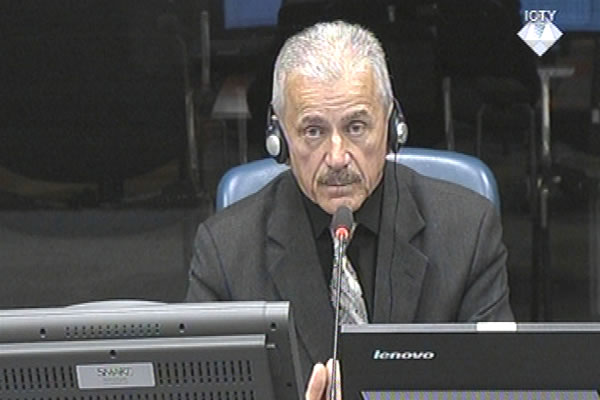Home
KARADZIC’S ‘BIOLOGICAL ANALOGIES’
Former president of the Srbac municipality Milos Milincic testified in Ratko Mladic’s defense today. Milincic claims that before the war Radovan Karadzic advocated multi-ethnicity. ‘A garden is most beautiful when it has many colors and flowers’, Karadzic said. To counter those claims, the prosecutor highlighted some of the Bosnian Serb president’s speeches in the Assembly. For example, the prosecutor noted, Karadzic likened the interethnic co-existence to a garden saying ‘there are also plants that can’t grow side by side’, adding, ‘just like a dog and a cat can’t be in the same box’
 Milos Milincic, defence witness at Rako Mladic trial
Milos Milincic, defence witness at Rako Mladic trial War-time president of the Srbac municipality Milos Milincic said in his statement to Ratko Mladic’s defense that there was no discrimination of the non-Serbs or ethnic cleansing in the Northern BH town. ‘We were a positive exception and amid the evils of war, we were the least evil’, said the witness. Before the war, he taught Serbo-Croatian in school.
In his statement, the witness stressed that the Serb authorities in Srbac were on good terms with those in Davor, a village across the border in Croatia, despite the artillery harassment. As Milincic recounted,he met Mladic in August 1992 in Banja Luka. Mladic supported Milincic in his decision not to enter into conflict with Croats.
However, the cross-examination focused mostly not on General Mladic but on President Karadzic. The prosecutor referred toMilincic’s statement to the defense where he described a rally in Srbac in 1990. Karadzic addressed the crowd and expressed his support for multi-ethnicity in BH, saying, ‘Protect those people and your citizens. A garden is the most beautiful if you have a mix of different colors and flowers’. The prosecutor contested the witness’s testimony by quoting Karadzic's words from two speeches he made in the Assembly.
In March 1992, Karadzic said that separating the ethnic communities was not a peculiarity of the Balkans region. There are examples of it in Europe, he said, adding that in nature there were plants that cannot grow side by side. Such plants ‘have to move away’ to be able to develop’. This ‘plant analogy’ served to prove that there could be no co-existence in BH, the prosecutor argued. The witness replied that he didn’t know anything about that speech.
Next, the prosecutor played a video of a speech Karadzic made in the Assembly at a later date.Karadzic again uses biology, presenting what the presiding judge called a ‘biological example’:before the war the Serb nation was ‘forced’ to remain in an ‘artificial entity, BH’ with two other ethnic groups. Karadzic likened it to an experiment in which ‘a dog and a cat are put into a box together’. The witness admitted that the statements Karadzic made later deviated from his views about a multi-ethnic ‘multi-colored garden’. According to the witness, Karadzic changed his attitude because of the many brutal clashes during the ‘breakdown of BH’.
Karadzic’s idea to separate the ethnic communities resulted in the expulsion of Croats and Muslims from Srbac in the period from 1992 to 1995. Before the war, Croats and Muslims made up 10 per cent of the municipality’s population. In the statement, the witness said that only 60 non-Serbs left Srbac during the war ‘for economic reasons’. The witness was shown a document of Banja Luka State Security Service which states that 600 of the 940 Muslims and 100 of the 145 Croats left Srbac. The witness agreed that the data were valid, noting that he should have explained in the statement that 60 non-Serb families had left the town, not 60 individuals.
As today’s hearing drew to a close, the defense called Dusko Corokalo, who was a soldier in the VRS 6th Sana Brigade during the war.
Linked Reports
- Case : Mladic
- 2014-11-13 ‘IGNORANT TYPIST’ MADE A MISTAKE
- 2014-11-12 NO MUSLIMS IN ROGATICA BY THE END OF WAR
- 2014-11-11 ‘SERB’ OR ‘INDEPENDENT’ AUTONOMOUS REGIONS?
- 2014-11-18 ARKAN AND ‘ARKAN’S MEN’ ARE RESPONSIBLE
- 2014-11-19 MAKING MUSLIMS FEEL LIKE THEY LIVED ‘IN A GHETTO’
- 2014-11-19 ‘SELF-ORGANIZED’ SERB GUARDS IN ROGATICA
